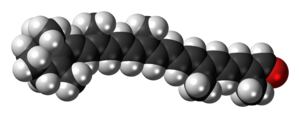
| |

| |
| Names | |
|---|---|
|
IUPAC name
8′-Apo-β-caroten-8′-al
| |
|
Systematic IUPAC name
(2E,4E,6E,8E,10E,12E,14E,16E)-2,6,11,15-Tetramethyl-17-(2,6,6-trimethylcyclohex-1-en-1-yl)heptadeca-2,4,6,8,10,12,14,16-octaenal | |
Other names
| |
| Identifiers | |
3D model (
JSmol)
|
|
| ChEBI | |
| ChemSpider | |
| ECHA InfoCard | 100.012.883 |
| E number | E160e (colours) |
PubChem
CID
|
|
| UNII | |
CompTox Dashboard (
EPA)
|
|
| |
| |
| Properties | |
| C30H40O | |
| Molar mass | 416.649 g·mol−1 |
Except where otherwise noted, data are given for materials in their
standard state (at 25 °C [77 °F], 100 kPa).
| |
Apocarotenal, or trans-β-apo-8'-carotenal, is a carotenoid found in spinach and citrus fruits. Like other carotenoids, apocarotenal plays a role as a precursor of vitamin A, even though it has 50% less pro-vitamin A activity than β-carotene. The empirical chemical formula for apocarotenal is C30H40O.
Apocarotenal has an orange to orange-red colour and is used in foods, pharmaceuticals and cosmetic products. Depending on the product forms, apocarotenal is used in fat based food ( margarine, sauces, salad dressing), beverages, dairy products and sweets. Its E number is E160e and it is approved for usage as a food additive in the US, [1] EU [2] and Australia and New Zealand. [3]
Possible carcinogenicity
Epidemiological studies have shown that people with high β-carotene intake and high plasma levels of β-carotene have a significantly reduced risk of lung cancer[ citation needed]. However, studies of supplementation with large doses of β-carotene in smokers have shown an increase in cancer risk, possibly because excessive β-carotene results in breakdown products that reduce plasma vitamin A and worsen the lung cell proliferation induced by smoke [ citation needed]. The chief β-carotene breakdown product suspected of this behavior is trans-beta-apo-8'-carotenal (common apocarotenal) [ citation needed], which has been found in one study to be mutagenic and genotoxic in cell cultures which do not respond to β-carotene itself. [4]
References
- ^ US FDA: "Colour Additive Status List". Food and Drug Administration. Retrieved 2011-10-27.
- ^ UK Food Standards Agency: "Current EU approved additives and their E Numbers". Retrieved 2011-10-27.
- ^ Australia New Zealand Food Standards Code "Standard 1.2.4 - Labelling of ingredients". Retrieved 2011-10-27.
- ^ Alija AJ, Bresgen N, Sommerburg O, Siems W, Eckl PM (2004). "Cytotoxic and genotoxic effects of β-carotene breakdown products on primary rat hepatocytes". Carcinogenesis. 25 (5): 827–31. doi: 10.1093/carcin/bgh056. PMID 14688018.
External links
- Some info on apocarotenal
- Olson, A.J. (1964). "The biosynthesis and metabolism of carotenoids and retinol (vitamin A)" (PDF). Journal of Lipid Research. 5 (3): 281–298. doi: 10.1016/S0022-2275(20)40196-8. PMID 5334361.

| |

| |
| Names | |
|---|---|
|
IUPAC name
8′-Apo-β-caroten-8′-al
| |
|
Systematic IUPAC name
(2E,4E,6E,8E,10E,12E,14E,16E)-2,6,11,15-Tetramethyl-17-(2,6,6-trimethylcyclohex-1-en-1-yl)heptadeca-2,4,6,8,10,12,14,16-octaenal | |
Other names
| |
| Identifiers | |
3D model (
JSmol)
|
|
| ChEBI | |
| ChemSpider | |
| ECHA InfoCard | 100.012.883 |
| E number | E160e (colours) |
PubChem
CID
|
|
| UNII | |
CompTox Dashboard (
EPA)
|
|
| |
| |
| Properties | |
| C30H40O | |
| Molar mass | 416.649 g·mol−1 |
Except where otherwise noted, data are given for materials in their
standard state (at 25 °C [77 °F], 100 kPa).
| |
Apocarotenal, or trans-β-apo-8'-carotenal, is a carotenoid found in spinach and citrus fruits. Like other carotenoids, apocarotenal plays a role as a precursor of vitamin A, even though it has 50% less pro-vitamin A activity than β-carotene. The empirical chemical formula for apocarotenal is C30H40O.
Apocarotenal has an orange to orange-red colour and is used in foods, pharmaceuticals and cosmetic products. Depending on the product forms, apocarotenal is used in fat based food ( margarine, sauces, salad dressing), beverages, dairy products and sweets. Its E number is E160e and it is approved for usage as a food additive in the US, [1] EU [2] and Australia and New Zealand. [3]
Possible carcinogenicity
Epidemiological studies have shown that people with high β-carotene intake and high plasma levels of β-carotene have a significantly reduced risk of lung cancer[ citation needed]. However, studies of supplementation with large doses of β-carotene in smokers have shown an increase in cancer risk, possibly because excessive β-carotene results in breakdown products that reduce plasma vitamin A and worsen the lung cell proliferation induced by smoke [ citation needed]. The chief β-carotene breakdown product suspected of this behavior is trans-beta-apo-8'-carotenal (common apocarotenal) [ citation needed], which has been found in one study to be mutagenic and genotoxic in cell cultures which do not respond to β-carotene itself. [4]
References
- ^ US FDA: "Colour Additive Status List". Food and Drug Administration. Retrieved 2011-10-27.
- ^ UK Food Standards Agency: "Current EU approved additives and their E Numbers". Retrieved 2011-10-27.
- ^ Australia New Zealand Food Standards Code "Standard 1.2.4 - Labelling of ingredients". Retrieved 2011-10-27.
- ^ Alija AJ, Bresgen N, Sommerburg O, Siems W, Eckl PM (2004). "Cytotoxic and genotoxic effects of β-carotene breakdown products on primary rat hepatocytes". Carcinogenesis. 25 (5): 827–31. doi: 10.1093/carcin/bgh056. PMID 14688018.
External links
- Some info on apocarotenal
- Olson, A.J. (1964). "The biosynthesis and metabolism of carotenoids and retinol (vitamin A)" (PDF). Journal of Lipid Research. 5 (3): 281–298. doi: 10.1016/S0022-2275(20)40196-8. PMID 5334361.